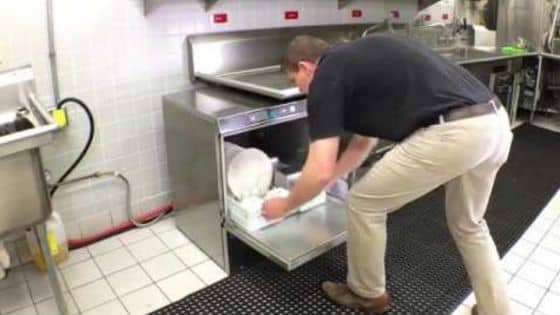As an Amazon Associate, I earn from qualifying purchases
Choosing a dishwasher for your home or business can be an overwhelming task, mainly because of the vast array of options available. One significant division within these options dwells on temperature settings: High Temp vs Low Temp Dishwashers. But how different are they? This post will delve into the specifics, benefits, and drawbacks of each option and guide you in making an informed decision.

Welcome to our blog where we delve into the world of appliances and more. Our aim is to provide you with accurate, insightful, and easy-to-understand information to help you make informed decisions. Stay tuned for more appliance guides, tips, and comparisons to simplify your purchasing process and ensure you get the best value for your money.
High-Temperature Dishwashers
High-temperature dishwashers, as the name implies, employ heated water at a temperature range of 150 – 160 degrees Fahrenheit to clean and sanitize your dishes.
Advantages of High-Temperature Dishwashers:
Superior cleaning: High temperatures effectively dissolve grease and can handle tough stains.
Efficient sanitization: The heat kills most bacteria, ensuring your dishes are not just clean, but sanitary.
Faster drying times: Since hot water evaporates faster, your dishes dry quicker.
Disadvantages of High-Temperature Dishwashers:
Energy consumption: They are typically less energy-efficient due to the heat.
Can damage some materials: Extremely high temperatures may not be suitable for delicate dishware.
Low-Temperature Dishwashers
On the other hand, low-temperature dishwashers clean dishes using water at a moderate heat of around 120 degrees Fahrenheit and then add a chemical sanitizing agent.
Advantages of Low-Temperature Dishwashers:
Energy efficient: They utilize less energy as they do not need to heat the water to high temperatures.
Gentle on delicate dishes: This option is perfect for fragile dishes as it avoids high heat.
Disadvantages of Low-Temperature Dishwashers:
They require additional sanitizing chemicals.
Some individuals may have sensitivity to these sanitizing chemicals.
Benefits of a High-Temperature Dishwasher

Long-lasting Quality
The robust nature of high-temperature dishwashers enhances their durability, maintaining superior performance even after extended use.
Efficacy against Stubborn Residues
They are exemplary in managing stubborn food residues and heavy soiling, preventing you from having to rinse or pre-wash your dishes before loading.
No Reliance on Chemical Sanitizers
High-temperature dishwashers do not require any extra chemical sanitizers, minimizing possible reactions for users who may be allergic to specific ingredients found in these products.
Drawbacks of a High-Temperature Dishwasher
Cost Implications
The initial purchase, installation, and maintenance costs of these types of dishwashers tend to be higher compared to their low-temperature counterparts.
Noise Level
High-temperature dishwashers generally operate at a higher noise level due to the machinery necessary to heat the water.
Benefits of Low-Temperature Dishwashers
Lower Energy Consumption
The main advantage of low-temperature dishwashers is their energy efficiency. Because they don’t need to heat water to as high a temperature, they use less power, resulting in reduced energy bills.
Quieter Operation
In comparison to their high-temperature counterparts, low-temperature dishwashers operate more quietly, leading to a more peaceful environment in your kitchen or workspace.
Lower Initial Costs
Low-temperature dishwashers are generally less expensive to buy, install, and maintain than high-temperature models, making them a cost-effective choice for many households and businesses.
Drawbacks of Low-Temperature Dishwashers
Additional Costs for Sanitizing Agents
One of the disadvantages is the need for chemical sanitizing agents, which is an added expense and is necessary for each wash cycle.
Less Effective Against Stubborn Residue
Low-temperature models can struggle slightly with heavily soiled items or stubborn food residues, which might necessitate pre-washing or rinsing.
Allergy or Sensitivity to Chemicals
For those with allergies or sensitivities, the chemicals used for the sanitizing process may pose a problem.
In summary, the choice between high-temperature and low-temperature dishwashers ought to be dictated by your unique circumstances, preferences, budgets, and the specific needs tied to your dishwashing routine. The key is to understand the distinctive features, advantages, and limitations of both types to make the most informed decision for your home or business.
How To Start a Dishwasher

Starting a dishwasher is not as complicated as it might seem. Here’s a general step-by-step guide:
Load your dishwasher properly. Be sure not to overfill it and to load everything in the correct places for optimum cleaning.
Pour dishwashing detergent into the dispenser. The amount of detergent required will depend on your specific dishwasher model and the hardness of your local water.
Select the correct wash cycle and any optional settings, such as high heat or sanitize.
Close the dishwasher door and latch it securely. If the door is not latched, the dishwasher will not start.
Press the start button. In some models, you may hear a slight hum indicating that the dishwasher has started its cycle.
Remember, every dishwasher model has its own specific functions and features, so always follow the instructions provided in the user manual for the best results. If your dishwasher fails to start, it could be due to various issues like a damaged latch, a malfunctioning timer, or issues with the power supply. In such cases, it would be wise to seek help from a professional repair service.
High Temp vs Low Temp Dishwashers Pros and Cons
Here’s an overview of their pros and cons to assist you in weighing your options:
High Temp Dishwasher Pros:
- Superior cleaning and sanitization
- Faster drying times
- Durable and high-quality performance over time
- Effective against heavy soiling and stubborn residues
High Temp Dishwasher Cons:
- Higher energy consumption
- Potential for damage to delicate dishware
- Higher initial and maintenance costs
- Noticeably noisier operation
Low Temp Dishwasher Pros:
- Lower energy consumption
- Less likely to damage delicate dishware
- Conversion-friendly due to quieter operation
- Generally less expensive to purchase and maintain
Low Temp Dishwasher Cons:
- Necessitates additional sanitizing
- chemicals
- May struggle with heavily soiled or stained dishes
- Potential for allergic reactions to sanitizing chemicals
- Possibly longer drying times
In making your decision about High Temp vs low-temperature dishwashers, consider aspects such as your budget allocation, how crucial energy efficiency is to you, the kind of dishware you regularly wash, and your preferred balance between chemical use and heat intensity.
High-Temp Dishwasher Temperature
High-temperature dishwashers typically operate at a minimum of 180 degrees Fahrenheit for the final rinse cycle. This high heat not only cleans the dishes but also works as an effective sanitizing mechanism, killing most bacteria and germs on contact. Conversely, the wash cycle in these dishwashers usually operates at a temperature of around 150 degrees Fahrenheit.
Low-Temp Dishwasher Temperature
Low-temperature dishwashers usually operate at a much lower temperature, typically around 120 degrees Fahrenheit. However, to compensate for the lower heat, these units rely on chemical sanitizers to ensure the dishes are thoroughly cleaned and sanitized.
Dishwashing Temperature Guidelines

Perhaps one of the most important aspects when choosing your dishwasher is understanding and adhering to the recommended dishwashing temperature guidelines.
High-Temp Dishwasher Guidelines
For high-temp dishwashers, a minimum of 150 degrees Fahrenheit is required for the wash cycle and at least 180 degrees Fahrenheit for the final rinse. This ensures optimal cleaning and sanitation but can be potentially damaging to delicate dishware.
Low-Temp Dishwasher Guidelines
Conversely, low-temp dishwashers operate at around 120 degrees Fahrenheit. They require the use of chemical sanitizers throughout the wash cycle to achieve the same level of sanitation. Make sure to follow the manufacturer’s guidelines for using these sanitizers to avoid any potential harm to your dishes or health.
Remember, the high temperatures used in high-temp dishwashers may cause certain types of dishware to warp or crack, while some people may have a material or health sensitivity to the chemicals used in low-temp dishwashers.
Making the Decision
When it comes to choosing between a high-temp and a low-temp dishwasher, consider the needs of your establishment, budget, and preferences carefully. If energy efficiency and reduced noise are important to you and you don’t mind the use of chemical sanitizers, a low-temp dishwasher may be the best fit for you.
However, if you want superior cleaning and sanitization and aren’t bothered by the higher noise level and potential for higher utility costs, a high-temp dishwasher may be more to your liking. Keep in mind the type of items you’ll be washing frequently. Delicate, easily damaged items might fare better in a low-temp dishwasher, whereas heavy-duty items with stubborn residue might require the intense heat provided by a high-temp dishwasher.
Additionally, pay attention to the ongoing costs, including the cost of energy, potential repairs, and maintenance for a high-temp machine versus the cost of chemical sanitizers for a low-temp one.
Conclusion: High Temp vs Low Temp Dishwashers
Both high-temperature and low-temperature dishwashers have their unique pros and cons. The ideal choice largely depends on your specific needs and circumstances.
If high-level cleaning and sanitation are of importance to you, and you don’t mind the energy consumption, a high-temperature dishwasher may be a good fit.
If energy saving and the care of delicate wares are more critical to your decision, a low-temperature dishwasher may be the better option, provided the use of sanitizing chemicals is not an issue for you.
In the end, understanding these differences can help you make a decision that meets your dish cleaning standards, respects your budget, and overall, enhances your kitchen experience.
High Temp vs Low Temp Dishwashers FAQs:
The main difference lies in their methods of dish sanitization. High-temp dishwashers use intense heat, while low-temp dishwashers use chemical sanitizers.
This depends on your perspective. High-temp dishwashers use more energy but avoid the use of chemicals. Conversely, low-temp dishwashers consume less energy but require sanitizing chemicals for effective cleaning.
High-temp dishwashers tend to have a higher upfront cost and can lead to higher utility bills due to their greater energy use. However, low-temp dishwashers may incur ongoing costs for chemical sanitizers, and in some cases, these can add up over time. It’s crucial to consider these factors when budgeting.
Typically, high-temp dishwashers are faster as they use heat to sanitize, eliminating the need for a longer chemical sanitization process. However, low-temp models might have longer drying times due to the lower operating temperature.
While high-temp dishwashers are excellent for heavy-duty items and stubborn residues, they may potentially damage delicate dishware. Low-temp dishwashers, on the other hand, are generally safer for fragile items, as long as the prescribed chemicals aren’t harmful to the dishware material.
Leave a Reply